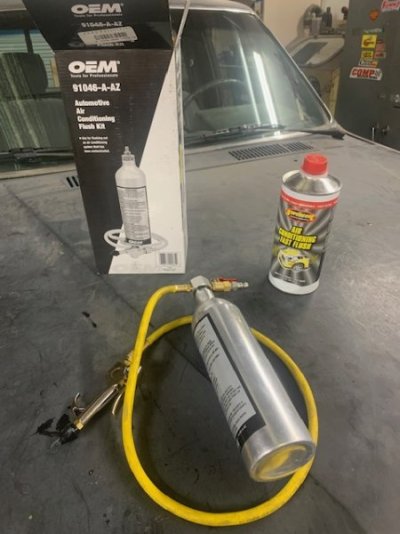- Local time
- 5:30 PM
- Joined
- Jul 9, 2019
- Messages
- 11,605
- Reaction score
- 30,546
- Location
- Modesto California
So, there are a few A/C threads running currently that I considered adding this to.. But they are mainly about new aftermarket systems which this isn't really needed for... This is more about trying to convert old R12 systems to R134... Back in the day there were chemicals available (mainly R141) that worked really well, just put it in the flush gun & blast away... Thanks to the EPA those days are gone, to do an effective job you have to use a few extra tricks...
So, first, since very few people own a A/C system flushing tool these days... Auto Zone has one in their loaner tool program... You give them $75 & they give you the tool... Return the tool in a timely manner & you get your $75 back... They don't typically sell the flushing solvent so they aren't making a dime... Thanks Auto Zone...

This time I ordered the flush solvent through Amazon... $14...
So, you have the tool & the solvent... But the tool isn't very effective cause the solvent is more like light oil or paint thinner than a hot solvent...
So you want to pulse the flush rather than just pushing it through the evaporator/condenser...
I add a ball valve to the discharge side of the component I'm flushing, that allows me to pressurize the component being flushed by opening both the inlet ball valve the the gun trigger with the rubber nozzle firmly sealed to the inlet port... I let the pressure push the solvent into the component & fully pressurize the component withe the discharge valve closed... Then I open the discharge forcing a rapid blast of solvent & air... I open & close the discharge valve a few times, causing solvent to blast through the component... Then I reverse the connections & flush the other way... And finally back the same way... By the time you've flushed three-four times the solvent is coming out very clean..
Discharge valve

Inlet gun

So, first, since very few people own a A/C system flushing tool these days... Auto Zone has one in their loaner tool program... You give them $75 & they give you the tool... Return the tool in a timely manner & you get your $75 back... They don't typically sell the flushing solvent so they aren't making a dime... Thanks Auto Zone...

This time I ordered the flush solvent through Amazon... $14...
So, you have the tool & the solvent... But the tool isn't very effective cause the solvent is more like light oil or paint thinner than a hot solvent...
So you want to pulse the flush rather than just pushing it through the evaporator/condenser...
I add a ball valve to the discharge side of the component I'm flushing, that allows me to pressurize the component being flushed by opening both the inlet ball valve the the gun trigger with the rubber nozzle firmly sealed to the inlet port... I let the pressure push the solvent into the component & fully pressurize the component withe the discharge valve closed... Then I open the discharge forcing a rapid blast of solvent & air... I open & close the discharge valve a few times, causing solvent to blast through the component... Then I reverse the connections & flush the other way... And finally back the same way... By the time you've flushed three-four times the solvent is coming out very clean..
Discharge valve
Inlet gun
















